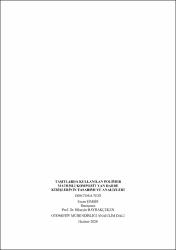Taşıtlarda kullanılan polimer matrisli kompozit yan darbe kirişlerinin tasarımı ve analizleri
Özet
Dünya’ da son zamanlarda otomotiv sektöründeki gelişmeler, taşıt sayısındaki artış ile çevresel problemlerin yanı sıra güvenlik de ön plana çıkmıştır. Günümüzde otomotiv endüstrisi yüksek güvenlik seviyelerine sahip, az yakıt tüketen otomobillerin geliştirilmesine ve düşük maliyetli üretim yöntemleri üzerine odaklanmaktadır. Bunun gerçekleştirilmesi için uygun tasarımların, daha hafif ve yüksek darbeleri sönümleme imkânı verecek malzemelerin kullanımı ile sağlanabilecektir. Taşıtta ağırlık azalımı her bölgede olduğu gibi şasi ve kaporta alanında da olmaktadır.
Yapılan çalışma ile otomobillerde yan darbe kirişlerde bir taraftan ağırlık azalımı ve yakıt tüketiminde düşme sağlanmış diğer taraftan da özellikle yan darbelere dayanıklı güvenli yapı oluşturulmuştur. Yapılan çalışmalar incelendiğinde genellikle metal kirişler daha ekonomik olduğu için tercih edilip kullanılmaktadır. Kompozitler çelik malzemeye göre çok daha hafif ve dayanıklı yapıya sahip olmasından dolayı son yıllarda kompozit malzeme kullanımı daha çok ön plana çıkmaktadır. Böylelikle kompozit malzemeler teknolojinin gelişmesi ile birlikte otomotiv sanayinde daha etkin kullanılmaya başlamıştır.
Çalışmada, bal petek sandviç yapılı kompozit kullanarak, uygun kiriş malzeme seçimi, numune malzemeler üretilmesi ve prototip yan darbe kiriş profil üretilmesi yapılmıştır. Bal petek sandviç yapıların üst yüzeyin de karbon fiber takviyeli epoksi malzeme, çekirdek malzeme olarak da Alüminyum ve Nomex bal peteği kullanılmıştır. Üretilen test numunelerine üç nokta eğme, çekme ve darbe testi uygulanmıştır. Farklı malzeme oryantasyonları kullanılarak kirişin dayanım, darbe, ağırlık vb. parametreleri deneysel olarak incelenmiştir. Yapılan deneyler sonucunda C48 dizilimine sahip karbon fiber fiziksel ve oryantasyon özellikleri nedeniyle seçilmiştir. C ve O olmak üzere iki farklı profil üzerinde çalışma yapılarak karbon fiber takviyeli polimer kompozit malzemeden yan darbe kirişi üretilmesi yapılmıştır. Üretimi yapılan C profil Alimünyum ve Nomex bal petek çekirdek yapılı ve O profil karbon fiber yan darbe kirişlere 2500 mm, 2750 mm ve 3000 mm yüksekliklerden serbest ağırlık düşürme metodu ile testler yapılmıştır. Böylelikle otomobillerde yan kirişlere gelen darbeleri engellemek için kullanılan kirişlerin optimal tasarımı gerçekleştirilebilecektir. Bir tarafdan alternatif kompozit malzemeler (karbon-elyaf takviyeli epoksi, polietilen) kullanılarak otomobillerde ağırlık azalımı ve yakıt tüketiminde düşme sağlanarak diğer taraftan ise özellikle yan kirişlerin darbelere karşı dayanıklılığı artırarak güvenli yapı oluşturulacaktır. In recent years, with the development in the automotive sector and the increase in the number of vehicles in the world, security problems have come to the forefront as well as environmental problems. Today, the automotive industry focuses on the development of low-fuel-consuming automobiles with high safety levels and low-cost production methods. Appropriate designs for achieving this can be achieved through the use of materials that allow lighter and higher pulsation damping. In the vehicle, weight reduction occurs in the chassis and bodywork area as in every region.
With the work done, a decrease in weight and fuel consumption will be achieved on the side impact beams in cars, and on the other hand, a safe structure that is resistant to side impacts has been created. When studies done up to now are examined, metal beams are generally preferred because they are more economical. In recent years composite materials have become more prominent. This is due to the fact that composites are much lighter and stronger than steel materials. Thus, with the development of composite materials technology, it has started to be used more effectively in the automotive industry.
In this study, using the honeycomb sandwich structure composite, appropriate beam material selection, sample materials and prototype side impact beam profiles were produced. Carbon fiber reinforced epoxy material on the top surface of honeycomb sandwich structures, Aluminum and Nomex honeycomb was used as core material. Three point bending, tensile and impact tests were applied to the produced test samples. By using different material orientations, the strength, impact, weight etc. parameters of the beam are experimentally examined. As a result of the experiments, carbon fiber material with C48 sequence was chosen. By working on two different profiles, C and O side impact beam was produced from carbon fiber reinforced polymer composite material. The produced C profile Aluminum and Nomex honey honeycomb core structure and O profile carbon fiber side impact beams were tested with free weight reduction method from 2500 mm, 2750 mm and 3000 mm heights. Thus, the optimal design of the beams used in cars to prevent impacts to the side beams can be realized. By using alternative composite materials (carbon-fiber reinforced epoxy, polyethylene) on one side, a decrease in fuel consumption and a reduction in fuel consumption will be provided, while on the other hand, a safety structure will be created by increasing the resistance of the side beams against impacts.
Bağlantı
https://hdl.handle.net/11630/8433Koleksiyonlar
- Doktora Tezleri [57]



















